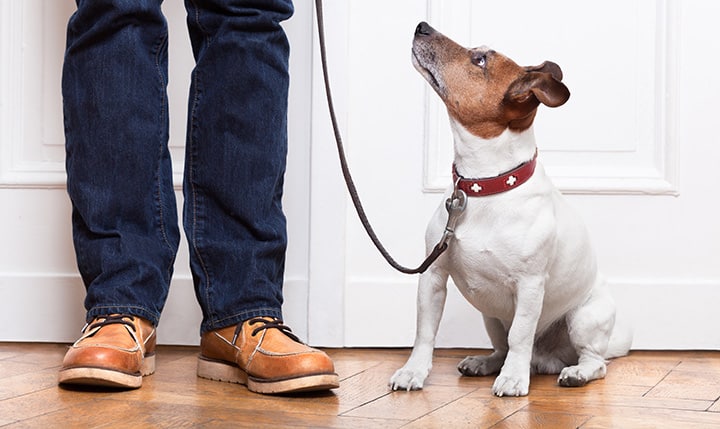I have spent time with dogs that are a little fluffy parcel sent from heaven and dogs that are a fiery furrball from hell. Adopting a rescue dog from the streets is an amazing experience and some of the sweetest dogs I\’ve worked with were rescue dogs. However, some rescue dogs can have aggression or anxiety issues resulting from their past. Dogs from breeders can also exhibit unwanted aggressive behavior. Many choose to use a dog training collar as a tool to help with behavior modification.
There are several types of dog training collars you can choose from. For the purposes of this article, we will focus on e-collars or more controversially put “shock collars.” This article will simply present information and leave you to choose the best option for your dog. If you have an aggressive dog at home, please seek out professional advice from a dog trainer before deciding on using any dog training collar. We encourage pet owners to make humane and safe decisions for their dogs!
Shock collars were first used in the 1960\’s with hunting dogs. Although they are not intended for punishment they do administer a shock. Most e-collars have varying levels of intensity and dog trainers recommend finding a \”working level\” for dog training. The working level is the intensity level at which a dog perceives stimulation that is not painful—but has a nagging, annoying quality. An e-collar is meant to be used as a deterrent to train away negative and unsafe behaviors until dogs no longer need prompting. These kind of collars can be used coinciding with the set boundary of an \”invisible fence\” or can be set to shock when a dog barks, triggered by the vibration of vocal cords.
Here are ten things to keep in mind when considering a dog training collar for your pooch.
1. Types of Collars
Regular
Flat
A flat collar is the standard collar for dogs. This collar is not considered a training collar—its only functionality is attaching identification and a leash. For proper fitting, allow two fingers width for wiggle room.
Martingale
Also known as a \”limited-slip collar,\” a martingale is designed for dogs with narrow heads like Afghan hounds or Greyhounds. The collar has a length of material with a metal ring at each end. A separate loop of material slips through each ring and a leash is attached to the ring at the end of this loop. If the dog\’s head begins to slip out, the leash will contract. If properly fitted, the collar will tighten to the size of your dog\’s neck without choking them.
Head Collar
A head collar fits similarly to a horse\’s halter. One strap fits around a dog\’s neck—sitting high on their head—while the other strap forms a loop around the dog\’s muzzle. The leash attaches to the bottom of the muzzle loop. This leash is typically used for large dogs with the strength to jump and pull at the leash.
Aversive Collars
Choke Chain
This collar is made with metal links that tighten around a dog\’s neck if they pull against the leash. The leash is supposed to fit high up on a dog\’s neck, above the ears. Unlike the martingale, you have no control over the extent of tightening, so it is possible to accidentally choke a dog with this chain.
Prong or Pinch Collar
Also like a martingale, a prong or pinch collar has a control loop that is made of chain. The chain on this leash has blunted points, fang-shaped metal links, or prongs that face inwardly at a dog\’s neck which pinches a dog\’s neck when they pull against a leash. The size of these prongs should be appropriate to the size of your dog, but even if fitted correctly, the prongs will shift toward your dog\’s trachea, pinching them.
E-Collar or Shock Collar
Shock collars use an electric current which passes through two metal contact points which signal a dog. Most shock collars have varying levels of intensity starting at no stimulation, to a working level, and finally a shocking, painful jolt.
Shock collars need to be fitted so that the prongs are nestled through the fur—against the skin. Caution! Shock collars can irritate and inflame a dog\’s skin. Don\’t leave a collar on for an extended amount of time and wash your dog\’s necks where the contact points touch the skin regularly.
2. Positive Reinforcement Vs. Aversive Behavior Modification
There are two schools of thought when it comes to dog training.
The first and, most industry-preferred method, is positive reinforcement. This is when trainers use rewards and positive incentives to train a dog. The key is to get your dog to associate wanted behavior with treats & affection and unwanted behavior with attention-withdrawal. E.g. If you want to get your dog to stop jumping up—turn around when they jump on you and do not give them attention until they are sitting calmly. Once they are calm, give them treats and affection.
The second method of training is aversive training. This is when trainers or dog owners use collars and other devices to train \”challenging\” dogs with correction or punishment. Reliance on physical discomfort and sometimes even pain is used to deter unwanted behavior.
Professional dog trainers will use both techniques depending on the case of a dog\’s needs. Your job as pet parents is to know the difference. Know the pros and cons of each to make a responsible decision on which training method you want to use with your dog.
3. Importance of Bonding
Both training techniques require developing a sense of trust and kinship with your dog. Using positive behavior reinforcement has the best results when a strong relationship exists. When a dog is eager to please and willing to modify their own behavior, each command you teach them will come quicker.
The same is true when using aversive dog training collars. A shock collar will effectively deter unwanted behaviors like jumping up or incessant barking but there is nothing to reward wanted behaviors like obeying a command to \”sit.\” Training with only negative feedback is not always enough to teach new commands.
Later in this article, we will take a look at a UK study which reviewed the effectiveness of using dog training collars that used electric currents contrasted with using positive behavior reinforcement.
Cons of Using Electric Dog Training Collars
4. The Shock
Most pet owners are uncomfortable with inflicting pain onto their pet. Even when e-collars\’ intensity can be adjusted, you are still using aversive behavior modification. Not every dog trainer knows to use the working level when training and inexperienced people can accidentally injure their dogs.
5. Misplaced Fear
If you have an aggressive or anxious dog, the last thing you want to do is instill fear. With shock training, some dogs begin to fear people, objects, or situations they begin to associate with the stimulus from the collar. The best way to counteract this disassociation is by limiting distraction when using a dog training collar. This will ensure that your dog associates pulling on the leash with the collar stimulus and not your neighbor\’s lawnmower.
6. Over-Correction
This happens when a shock or stimulus is administered with bad timing—too late for a dog to associate behavior with the shock—or when a boundary fence or automatic bark collar delivers shocks unintentionally or too often. Without proper dog training techniques with shock collars, a dog might develop an issue that wasn\’t there before. For instance, if a dog associates the collar\’s stimulus with being outside, they might start urinating in the house as a result of the shock administered by the electric fence.
7. No Positive Reward
The way a dog inherently learns is through experimentation. With positive reward association, a dog knows they will be given a treat once they figure out what they are supposed to do. Even teaching a puppy to sit for the first time relies on them correlating the act of sitting with the delicious taste of a treat. Using dog training collars as the only means of training limits training to only deterring unwanted behavior.
Pros of Using Electric Dog Training Collars
8. Adjustable Intensity
Most e-collars on the market have a range of stimulus intensities. They also have a warning beep or vibrate mode that precedes a shock. Other collars have sprays which administer harmless but foul scents like citronella or an ultrasonic sound which only a dog can hear.
9. Faster Training Results
Some pet owners and dog trainers report that it only takes a few shocks to correct an unwanted behavior. Robin Macfarlane, a professional dog trainer with nearly 30 years experience, uses e-collars with success. Macfarlane states that using an e-collar provides dogs with an easier learning curve.
10. You Don\’t Need to Present
Although sometimes problematic, if you have a dog that is constantly barking when you\’re not home, which is irritating the neighbors, e-collars can be a quick fix. A boundary control electric barrier will also continue working when you\’re not present. We do advise against leaving your dog unattended for a long period of time or with a shock collar on their neck.
Final Thoughts
Again, it is completely up to you as a dog parent to decide whether you want to use a dog training collar with your pooch. In the case of e-collars, the controversy exists and many will tell you not to use them like The Humane Society and the ASPCA. Still, there are professional dog trainers that endorse aversive training techniques like Robin MacFarlane and Cesar Millan.
In a UK scientific study, 63 pet dogs were used to find an objective scientific approach to the efficacy of using dog collars. The dogs were separated into three groups.
Group A was trained with shock collars by pro-shock dog trainers. Group B, the control group, was trained without shock collars from pro-shock trainers. Finally, Group C was trained without shock by trainers opposed to shock training. All three groups wore e-collars so there would be no difference in physical sensation (besides administered stimulus). This also ensured that observers of the training sessions could not tell which dog\’s were being trained with shocks to maintain unbiased results.
The findings reported that \”there were no differences between groups for a number of Corticosteroids in dogs\’ urine, a physiological marker of stress.\” Adversely, \”when it came to salivary cortisol, Group C dogs were actually the highest.\” As far as functionality of training, there were no differences between the three groups of dogs. 91.8% of owners reported in improvements in their dogs\’ behavior.
Splash and Dash Groomerie & Boutique encourages you to conduct your own research and consider your own dog\’s personality before making any final decisions.
Follow Splash and Dash Groomerie & Boutique:
- Website: http://splashanddashvip.com/
- Website: https://splashanddashfranchise.com/
- Facebook: https://www.facebook.com/splashanddashfordogs/
- Instagram: @splashanddashfordogs
- LinkedIn: https://www.linkedin.com/in/dan-j-barton-622ab517
- Twitter: splashanddash4dog



